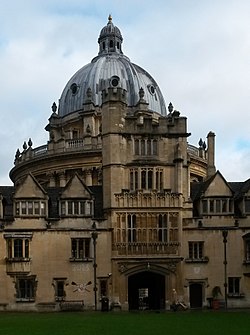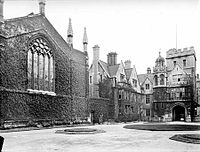Brasenose College, Oxford
| Brasenose College Latin: Aula regia et collegium aenei nasi
| |||||||||||
 The main gate of Brasenose College | |||||||||||
|---|---|---|---|---|---|---|---|---|---|---|---|
| Principal: | John Bowers | ||||||||||
| Website: | bnc.ox.ac.uk | ||||||||||
| |||||||||||
| Location | |||||||||||
| Grid reference: | SP51540632 | ||||||||||
| Location: | 51°45’12"N, 1°15’17"W | ||||||||||
Brasenose College is one of the constituent colleges of the University of Oxford. It began as Brasenose Hall in the 13th century, before being founded as a college in 1509. The library and chapel were added in the mid-17th century and the new quadrangle in the late 19th and early 20th centuries.
For 2020–21, Brasenose placed 4th in the Norrington Table (an unofficial measure of performance in undergraduate degree examinations).[1] In a recent Oxford Barometer Survey, Brasenose's undergraduates registered 98% overall satisfaction.[2] In recent years, around 80% of the UK undergraduate intake have been from state schools.[3][4][5]
Brasenose is home to one of the oldest rowing clubs in the world, Brasenose College Boat Club.
Contents
History
Foundation
The history of Brasenose College, Oxford stretches back to 1509, when the college was founded on the site of Brasenose Hall, a mediæval academic hall whose name is first mentioned in 1279.[6] Its name is believed to derive from the name of a brass or bronze knocker that adorned the hall's door.
The college was associated with Lancashire and Cheshire, the county origins of its two founders – Sir Richard Sutton and the Bishop of Lincoln, William Smyth – a link which was maintained strongly until the latter half of the twentieth century.[6][7][8] The first principals navigated Brasenose, with its Roman Catholic sympathisers, through the Reformation and continuing religious reforms.[9]
Most of Brasenose favoured the Royalist side during the Civil War, although it produced notable generals and clergy on both sides.[10]
The library and chapel were completed in the mid-17th century, despite Brasenose suffering continuing financial problems.[11][12]
Nineteenth century
After 1785 the college prospered under Principal William Cleaver.[13] The college began to be populated by gentlemen, its income doubling between 1790 and 1810,[14] and achieved considerable academic success.[15] But the reconstruction of Brasenose was not completed until the end of the 19th century with the addition of New Quad between 1886 and 1911.[16] Brasenose's financial position remained secure, although under the tenure of Principal Edward Hartopp Cradock Brasenose's academic record waned greatly, with much of its success focused on sport, where it excelled most notably in cricket and rowing.[17]
The mid-century Royal Commissions were navigated; although they were initially opposed, some recommendations were welcomed, including the election of fellows on merit rather than by their place of birth.[16] The election of Charles Heberden as principal in 1889 led to a gradual improvement in Brasenose's academic fortunes, although its sporting performance suffered.[18] As the first lay principal, Heberden presided over an increasingly secular college, which opened up the library to undergraduates, instituted an entrance exam for the first time and accepted Rhodes scholars.[19]
Early twentieth century
Brasenose lost 115 men in the First World War (including a quarter of the 1913 year), with its undergraduate numbers greatly reduced.[20]
Lord Curzon's post-War reforms were successfully instituted. The inter-war period was defined by William Stallybrass, who as fellow and eventual principal (until 1948) dominated college life.[21] Brasenose once again produced top sportsmen – cricketers, rowers, and others.[22] This came at the cost of falling academic standards and poorly performing finances, which would see Stallybrass' authority challenged. He died in a railway accident before he could be forced out, however.[23]
After the war, sporting achievements waned (although there were notable exceptions) but academic success did not improve significantly, in what was now one of Oxford's largest colleges.[24]
Location and buildings
Brasenose faces the west side of Radcliffe Square opposite the Radcliffe Camera in the centre of Oxford. The north side is defined by Brasenose Lane, while the south side reaches the High Street. To the west is Lincoln College. At its south-east end, the college is separated from the University Church by St Mary's Passage. The main entrance of the college can be found on Radcliffe Square. Although not located on Turl Street the college has informal links with the three Turl Street colleges (Lincoln, Jesus, and Exeter). The college is also physically linked to Lincoln College through a connecting door, through which Brasenose College members are permitted to enter Lincoln College on Ascension Day each year. The door is opened for five minutes and it is the only time during the year that this door is unlocked. Brasenose members are then served an ale by Lincoln College, which is traditionally flavoured with ground ivy.
The main college site comprises three quads, the original Old Quad, a small quad known as the Deer Park, and the large New Quad, as well as collection of smaller houses facing Radcliffe Square and the High Street. The original college buildings comprised a single two-storey quad, incorporating the original kitchen of Brasenose Hall on the south side. In the 17th century a third floor was added to the quad to form the current Old Quad. A separate chapel was also built to the south, connected to the quad by a library built over a cloister as shown in a 1670 print, thus enclosing the Deer Park. The cloister was for a time the college burial ground, and evidence suggests there were at least 59 people buried there, with the last recorded burial being in 1754. The cloister was filled in to make two or three chambers in around 1807, used as student bedrooms or administrative offices until 1971, when the space was converted into the graduate common room.
Dining hall
In the 16th century the dining hall was heated by an open fire in the centre of the room, supplemented by movable braziers. In the 1680s the hall was renovated, with a raised floor to accommodate a wine cellar below and a reconstructed roof. Another renovation phase in the mid-18th century included a new chimneypiece, a new ceiling to cover the original timber beams and two gilded chandeliers. The original brazen nose was placed above high table in 1890.[25]
Chapel and library
Building began on the current chapel in 1656, and it replaced an old chapel which was located in a space now occupied by the Senior Common Room. An inscription commemorates this above the door to Staircase IV. Building materials were taken from a disused chapel at the site of St Mary's College (now Frewin Hall), transported piece by piece by horse-and-cart to Brasenose College. The chapel, a mix of Gothic and Baroque styles, features a hanging fan vault ceiling of wood and plaster, and was consecrated in 1666.[25] The internal fittings are largely 18th and 19th century, and include chandeliers presented to the college in 1749. These were donated to a parish church and later converted to gas but then returned to Brasenose when the church switched to electric lights. The chandeliers were then converted back to their original state so that candles could be used in them once again.[26]
Various alterations were made to the Chapel after completion. Although repairs were undertaken in the meantime, the interior of the Chapel was renovated (having fallen into a poor state) in 1819, and the exterior beginning in 1841. In 1892–3 a new organ was purchased and fitted, paid for by the then Principal Charles Buller Heberden; the current organ was installed in 1973, and rebuilt in 2001–2.[27]
The current library was begun in 1658 and received its first books in 1664. It replaced a smaller library on Staircase IV, which is now used as a meeting room. The books in the current library were fixed by chains, which were only removed in the 1780s, over a hundred years later.[25]
In May 2018 author Philip Pullman opened the extensively renovated Greenland Library following a £4 million project to provide a better working space for students (architects - Lee/Fitzgerald). The library works were funded by three college alumni, Duncan Greenland, James Del Favero and Gerald Smith. Two reading rooms are named in honour of Del Favero and Smith respectively with the overall library taking Greenland's name[28] The renovations won an RIBA regional RIBA Conservation award in 2019.[29]
New Quad
New Quad was designed by Thomas Graham Jackson and finished in 1911, replacing a number of existing buildings. The current site was completed in 1961 with new buildings, used largely for first year undergraduate accommodation, designed by the architects Powell and Moya.[30]
In 2010 a project was begun to renovate the kitchens, servery, dining hall and some other areas of college. The project included the installation of under floor heating and a new timber floor in the dining hall, new kitchen equipment, a new servery area, additional dining and meeting places, and disabled access to the dining hall.[31] During the project, the Old Quad housed a temporary dining hall and kitchen, while the New Quad was used to store building materials.
Outside links
| ("Wikimedia Commons" has material about Brasenose College, Oxford) |
References
- ↑ "Undergraduate Degree Classifications". University of Oxford. https://www.ox.ac.uk/about/facts-and-figures/undergraduate-degree-classifications.
- ↑ Organ, Joe. "Applying to Brasenose this Autumn? – Brasenose College, Oxford" (in en). https://www.bnc.ox.ac.uk/about-brasenose/news/1780-applying-to-brasenose1.
- ↑ "Applying to Oxford? Read about our admissions statistics". https://www.bnc.ox.ac.uk/about-brasenose/news/2364-applying-to-oxford-read-about-our-admissions-statistics.
- ↑ "A-Level Admissions: Brasenose College admits 9% more undergraduates than normal, 79% from state schools". https://www.bnc.ox.ac.uk/about-brasenose/news/2294-a-level-admissions-brasenose-college-admits-9-more-undergraduates-than-normal-79-from-state-schools.
- ↑ "Thinking of Applying to Brasenose?". https://www.bnc.ox.ac.uk/about-brasenose/news/2252-thinking-of-applying-to-brasenose-2.
- ↑ 6.0 6.1 "A concise history of Brasenose". https://www.bnc.ox.ac.uk/about-brasenose/history/212-college-history/397-a-brief-history-of-brasenose.
- ↑ Buchan (1898). pp. 1–6.
- ↑ Crook (2008). p. 422.
- ↑ Crook (2008) pp. 27–29.
- ↑ Crook (2008). p. 50.
- ↑ Crook (2008). pp. 45–9.
- ↑ Buchan (1898). p. 81.
- ↑ Buchan (1898). p. 31.
- ↑ Crook (2008). pp. 162–163.
- ↑ Buchan (1898). p. 32.
- ↑ 16.0 16.1 A History of the County of Oxford - Volume 3 pp 207-219: Brasenose College (Victoria County History)
- ↑ Crook (2008). pp. 248–249, 260–261.
- ↑ Crook (2008). pp. 307–309.
- ↑ Crook (2008). pp. 311–316.
- ↑ Crook (2008). pp. 321–322.
- ↑ Crook (2008). pp. 324–326.
- ↑ Crook (2008). pp. 348–349.
- ↑ Crook (2008). pp. 359–383.
- ↑ Crook (2008). pp. 396–402.
- ↑ 25.0 25.1 25.2 Crook (2008).
- ↑ Brasenose College 1509–2009: pamphlet viewed September 2010
- ↑ "The Organ – Brasenose College, Oxford" (in en). https://www.bnc.ox.ac.uk/current-students/college-life/chapel/the-organ.
- ↑ "The Grand Opening of the Greenland Library: Saturday 5th May 2018 – Brasenose College, Oxford" (in en). https://www.bnc.ox.ac.uk/about-brasenose/news/1939-greenland-library.
- ↑ "Greenland Library by Lee/Fitzgerald Architects". Royal Institute of British Architects. https://www.architecture.com/awards-and-competitions-landing-page/awards/riba-regional-awards/riba-south-award-winners/2019/greenland-library.
- ↑ Nikolaus Pevsner: The Buildings of England: Oxfordshire, 1974 Penguin Books ISBN 978-0-300-09639-2
- ↑ Brasenose College Building Project Explained: Flyer viewed August 2010
- Crook, J Mordaunt (2008). Brasenose: The Biography of an Oxford College. Oxford University Press. ISBN 978-0199544868.
| Colleges of the University of Oxford | |
|---|---|
| Colleges:
All Souls • Balliol • Brasenose • Christ Church • Corpus Christi • Exeter • Green Templeton • Harris Manchester • Hertford • Jesus • Keble • Kellogg • Lady Margaret Hall • Linacre • Lincoln • Magdalen • Mansfield • Merton • New College • Nuffield • Oriel • Pembroke • The Queen's • Reuben • St Anne's • St Antony's • St Catherine's • St Cross • St Edmund Hall • St Hilda's • St Hugh's • St John's • St Peter's • Somerville • Trinity • University • Wadham • Wolfson • Worcester |
|
| Permanent private halls:
Blackfriars • Campion Hall • Regent's Park College • St Benet's Hall • St Stephen's House • Wycliffe Hall | |







